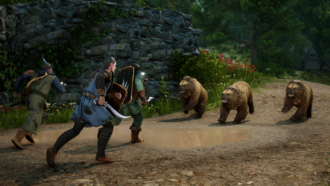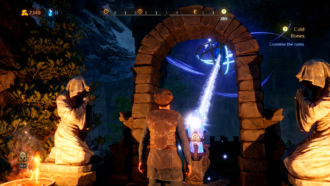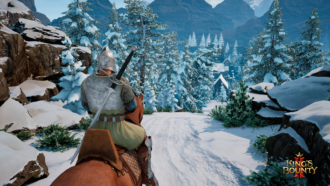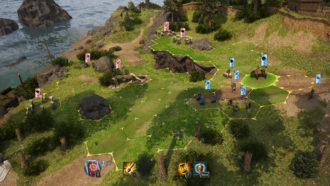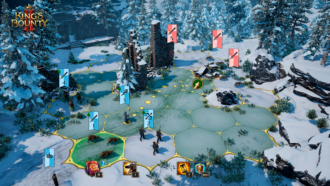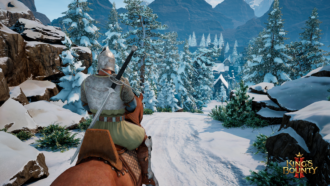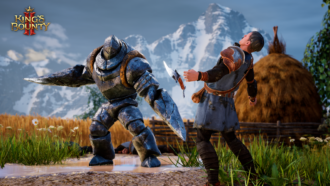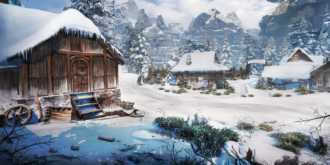Originally created in 1990 by Jon Van Caneghem, the King’s Bounty franchise has a rich history in the realm of turn-based strategy. The original game is considered something of a spiritual predecessor to the Heroes of Might & Magic franchise that Van Canegham would go on to create. Although King’s Bounty saw a remake in 2008, which itself spawned several spin-offs, the franchise has been otherwise dormant… until now.
King’s Bounty II, developed by 1C Entertainment, brings the franchise back to life by combining the tried and true strategic gameplay with a more cinematic narrative presentation and open world setting reminiscent of titles like The Witcher 3: Wild Hunt. Based on my time with it so far, I am excited to see what is to come, even if it has some interface issues and gameplay features that may need improvement.
You start off picking one of three protagonists to play as. Regardless of who you choose, the general narrative progression is mostly the same, with certain NPC dialogue changing based on your main character. Furthermore, the different playable characters have different starting stat allocations, passive abilities for their troops and ideal affinities. After being released from prison in the fantasy kingdom of Nostria, you leave to travel to the nation’s capital to try and bring order to the chaos and lawlessness that has impacted the land. From bandits to interspecies tensions to undead hordes, you have your work cut out for you to restore peace.
Even in the few hours I played, I was impressed at the degree of non-linearity on display. While travelling around, you can encounter side-quests, that may reward you with bonus equipment, resources, units or experience. Oftentimes you will be required to make a choice of siding with one of two parties or making a tactical decision of how to resolve a conflict. These choices align with one of the four ideals: Order, Power, Finesse and Anarchy. As you make consistent moral decisions, you steadily gain points in those ideals. Units also have ideal alignments, and will have lowered morale (which impacts chances to get bonus turns) if put in a squad with units of incompatible alignments.
At first I found it a bit restrictive to disadvantage putting powerful units of different ideals in a party. However, once I had gotten used to the system and acquired a greater variety of units, it started to click a bit more. You can sink your talent points on level up into abilities that mitigate the morale impact of blending ideal types. Plus, it made role-playing a bit more interesting, as my decisions would have mechanical impacts on how effective my units are.
Once you have recruited your units and started an encounter, combat begins. Combat takes place on a map with several hexagonal spaces that your units can move across. At first it seems a bit basic, but grows in complexity as more unit types are unlocked. These include skeleton units, who resist ranged attacks, mage units who can summon other units, and flying units that can go across gaps. The added 3D element in King’s Bounty II presents the biggest gameplay innovation over prior games, which is the addition of elevated terrain and cover. This provides additional ways to avoid ranged attacks, and make yourself difficult to access by melee fighters.
It should also be mentioned that King’s Bounty II does not pull its punches in gameplay. Most fights will end in casualties, requiring a trip back to the recruiter to spend your winnings on new soldiers. Unless you make sure to keep your army topped up at all times, you will often find the enemy outnumbering you as well, encouraging defensive play and making good use of cover and bottlenecks in the battlefield. Although this game is somewhat aimed at series veterans, more difficulty options to make the game accessible to those more interested in the story may be desirable.

The other major addition is the open-world exploration. Nostria itself is quite vibrant and detailed, with plenty of hidden collectables and world-building notes to find. I especially liked small environmental details, like flocks of birds flying away as you approach them on horseback. However, the implementation is not perfect. There are fast travel points, however they are not always positioned close to combat areas, and you need to be next to one to travel somewhere else.
You have a horse that can be summoned at the press of a button. Unfortunately, said horse isn’t very fast and cannot go indoors. Considering how spread apart vendors can be, and how you can only sell trash at SOME vendors but not all of them, the busywork between combat could stand to be made more efficient. The ability to fast travel from anywhere via a map menu would be good. Even just making the horse a bit faster would be an improvement.
In terms of the combat, while the user interface works for the most part, it has the odd habit of boxes overlapping one another on occasion. If you’re hovering your cursor over the enemy unit to preview how effective your attack is about to be, the enemy health bar covers up your unit’s health bar unless you rotate the camera to a specific angle.
The projected combat outcome interface would be much more readable if the boxes were separated more, or perhaps showed up in fixed locations on the side of the screen. UI graphical improvements are on the developer’s list of priorities, so hopefully that will be updated for the full release.
The time I have spent with King’s Bounty II so far shows signs of promise. While combat can be challenging, it is manageable and engaging once you are more familiar with the morale system and figure out how important status effects can be. The open world element is also mostly a success, even if I wish that replenishing your army and supplies could be made more convenient. With King’s Bounty’s successor franchise Heroes of Might & Magic essentially dormant for now, 2021 is as good a time as any for King’s Bounty II to fill that turn-based fantasy strategy void that it left behind.
King’s Bounty II will release for PC, PS4, Xbox One and Nintendo Switch on August 24th, 2021.
